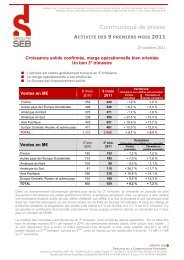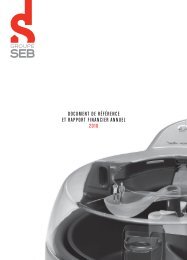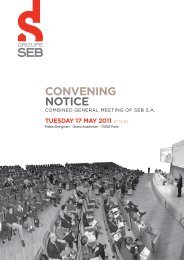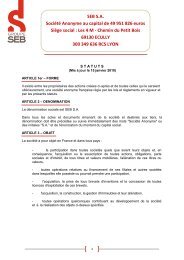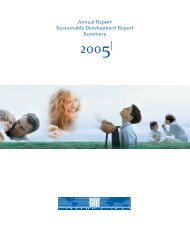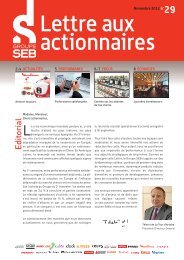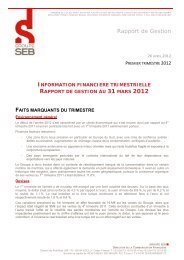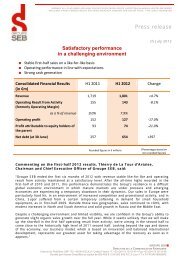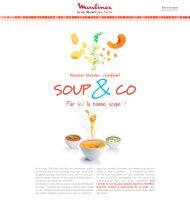financial report and registration document 2011 - Groupe SEB
financial report and registration document 2011 - Groupe SEB
financial report and registration document 2011 - Groupe SEB
Create successful ePaper yourself
Turn your PDF publications into a flip-book with our unique Google optimized e-Paper software.
5 Notes<br />
Consolidated fi nancial statements<br />
to the consolidated fi nancial statements<br />
Note 25.3. INFORMATION ON FINANCIAL ASSETS AND LIABILITIES MEASURED AT FAIR VALUE<br />
In accordance with the amended IFRS 7, fair value measurements are<br />
classifi ed using a fair value hierarchy that refl ects the signifi cance of the<br />
inputs used in making the measurements. The hierarchy breaks down into<br />
three levels, as follows:<br />
� level 1: quoted prices in active markets for the same instrument;<br />
(in € millions)<br />
� level 2: quoted prices in active markets for similar assets or liabilities or<br />
other valuation techniques for which all signifi cant inputs are based on<br />
observable market data;<br />
� level 3: valuation techniques for which any signifi cant input is not based<br />
on observable market data.<br />
31 December <strong>2011</strong><br />
Total Level 1 Level 2 Level 3<br />
Assets<br />
Derivative instruments 8.0 8.0<br />
Cash <strong>and</strong> cash equivalents 196.0 196.0<br />
TOTAL FINANCIAL ASSETS MEASURED<br />
AT FAIR VALUE<br />
Liabilities<br />
204.0 196.0 8.0<br />
Derivative instruments 17.6 17.6<br />
TOTAL FINANCIAL LIABILITIES MEASURED<br />
AT FAIR VALUE 17.6 17.6<br />
The portfolio of derivatives used by the Group to manage risk mainly<br />
includes forward currency contracts, interest rate <strong>and</strong> currency swaps <strong>and</strong><br />
NOTE 26 FINANCIAL RISK MANAGEMENT<br />
Note 26.1. RISK MANAGEMENT<br />
Risks are managed by Corporate Finance, based on <strong>financial</strong> market<br />
conditions <strong>and</strong> in accordance with procedures established by the Group.<br />
Hedging transactions are carried out in the <strong>financial</strong> markets with a<br />
limited number of high-quality partners in order to avoid counterparty risk.<br />
Subsidiaries’ risks are hedged at corporate level when this is allowed under<br />
the laws <strong>and</strong> regulations of the country concerned <strong>and</strong> when the hedges<br />
can be arranged on the fi nancial markets.<br />
Subsidiaries that are prevented from hedging <strong>financial</strong> risks through<br />
Corporate Finance due to local laws <strong>and</strong> regulations enter into hedging<br />
transactions directly with local banks in compliance with Group procedures<br />
<strong>and</strong> policies.<br />
Note 26.2. MARKET RISKS<br />
26.2.1. Currency risks<br />
The majority of Group sales are billed in currencies other than the euro,<br />
mainly the US dollar, Russian ruble, Brazilian real <strong>and</strong> Japanese yen. Most<br />
commodities options. These instruments are classifi ed as Level 2, as their fair<br />
value is calculated using internal valuation models based on observable data.<br />
billing currencies correspond to the functional currencies of the subsidiaries<br />
concerned <strong>and</strong> do not give rise to any transactional currency risk at the<br />
local level.<br />
Similarly, goods purchased for resale billed in US dollars are bought from<br />
Asian suppliers by <strong>SEB</strong> Asia whose functional currency is also the US dollar.<br />
The main sources of transactional currency risks therefore arise from:<br />
� intra-group billings between two Group companies with different functional<br />
currencies, as follows:<br />
� exports by manufacturing subsidiaries in the euro zone billed in the<br />
local currency of the marketing subsidiaries,<br />
� imports of goods from <strong>SEB</strong> Asia billed in US dollars by marketing<br />
subsidiaries whose functional currency is not the US dollar;<br />
� purchases of industrial components from external suppliers by the<br />
manufacturing subsidiaries, that are billed in a currency other than their<br />
functional currency (for example, components purchases by French<br />
subsidiaries that are billed in US dollars).<br />
These risks are managed at Group level by <strong>SEB</strong> S.A., which acts as the<br />
subsidiaries’ sole counterparty except where this is not possible due to<br />
local regulations. The resulting balance sheet currency positions in the main<br />
124 GROUPE <strong>SEB</strong> Financial Report <strong>and</strong> Registration Document <strong>2011</strong>



